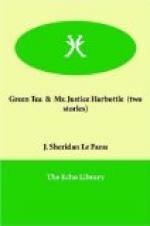The reference is to Vol. I., Section 317, Note Z^{a}. The note to which reference is thus made, simply says: “There are two accounts of the remarkable case of the Honourable Mr. Justice Harbottle, one furnished to me by Mrs. Trimmer, of Tunbridge Wells (June, 1805); the other at a much later date, by Anthony Harman, Esq. I much prefer the former; in the first place, because it is minute and detailed, and written, it seems to me, with more caution and knowledge; and in the next, because the letters from Dr. Hedstone, which are embodied in it, furnish matter of the highest value to a right apprehension of the nature of the case. It was one of the best declared cases of an opening of the interior sense, which I have met with. It was affected too, by the phenomenon, which occurs so frequently as to indicate a law of these eccentric conditions; that is to say, it exhibited what I may term, the contagious character of this sort of intrusion of the spirit-world upon the proper domain of matter. So soon as the spirit-action has established itself in the case of one patient, its developed energy begins to radiate, more or less effectually, upon others. The interior vision of the child was opened; as was, also, that of its mother, Mrs. Pyneweck; and both the interior vision and hearing of the scullery-maid, were opened on the same occasion. After-appearances are the result of the law explained in Vol. II., Section 17 to 49. The common centre of association, simultaneously recalled, unites, or reunites, as the case may be, for a period measured, as we see, in Section 37. The maximum will extend to days, the minimum is little more than a second. We see the operation of this principle perfectly displayed, in certain cases of lunacy, of epilepsy, of catalepsy, and of mania, of a peculiar and painful character, though unattended by incapacity of business.”
The memorandum of the case of Judge Harbottle, which was written by Mrs. Trimmer, of Tunbridge Wells, which Doctor Hesselius thought the better of the two, I have been unable to discover among his papers. I found in his escritoire a note to the effect that he had lent the Report of Judge Harbottle’s case, written by Mrs. Trimmer, to Dr. F. Heyne. To that learned and able gentleman accordingly I wrote, and received from him, in his reply, which was full of alarms and regrets, on account of the uncertain safety of that “valuable MS.,” a line written long since by Dr. Hesselius, which completely exonerated him, inasmuch as it acknowledged the safe return of the papers. The narrative of Mr. Harman, is therefore, the only one available for this collection. The late Dr. Hesselius, in another passage of the note that I have cited, says, “As to the facts (non-medical) of the case, the narrative of Mr. Harman exactly tallies with that furnished by Mrs. Trimmer.” The strictly scientific view of the case would scarcely interest the popular reader; and, possibly, for the purposes of this selection, I should, even had I both papers to choose between, have preferred that of Mr. Harman, which is given, in full, in the following pages.




